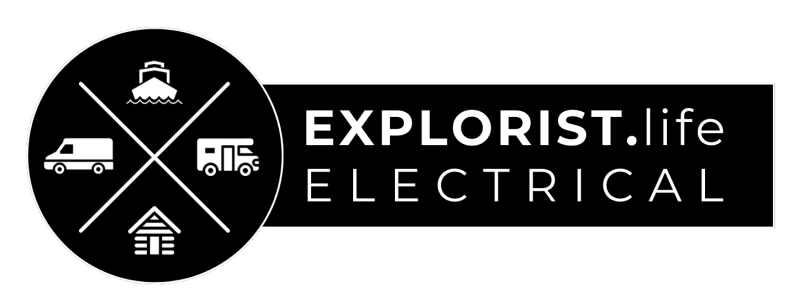
Did you know that 0 gauge wire is bigger than 4 gauge wire and 4/0 wire is bigger than both of them? Confusing, I know, but clearing up all confusion about wire sizes is exactly what I’m going to teach you in lesson #2 of this Wire Basics Chapter.

Understanding Wire Sizes VIDEO

What do wire sizes and gauges mean?
In the United States, The smallest wire we typically use in a mobile, marine, or off-grid electrical system is 18 gauge, which is abbreviated AWG, for American Wire Gauge. The largest size is 4/0.
And here’s a ‘to scale’ graphic of what it looks like in between:

From smallest to biggest, we just start counting backward by two: 18, 16, 14, all the way to two. After two, they decided to add a 1 gauge. I don’t know why odd-numbered gauges above one aren’t really a thing, and maybe they are ‘technically’ available in specialized applications, but a “5 AWG wire” doesn’t really exist as a common size, but I digress.

Wire larger than 1 AWG is 0 AWG, which makes perfect sense.
But then, whoever came up with this mess needed bigger wires, but ran out of numbers smaller than 0 without going into the negative.
Instead of switching to, say, I don’t know… metric where they would list wire sizes as their actual dimensions in mm^2, we have decided to just start adding zeros.
So, wire sizes larger than 0 is, 2x zeros, 3x zeros, and 4x zeros:

…but that’s not how we say it. A less common word for Zero in old english is Naught; and since American English is a little different, we call it “aught” just like we do with the .30-06 rifle caliber *freedom noises*
So there you have it:
18AWG, 16AWG, 14AWG, 12AWG, 10AWG, 8AWG, 6AWG, 4AWG, 2AWG, 1AWG, 0AWG (Which is the same as 1/0 (you know… because one-zero), 00AWG (2/0), 000AWG (3/0), 0000AWG (4/0)

What about wire sizes larger than 4/0?
Wire sizes larger than 4/0 aren’t really a thing in mobile, marine, and off-grid applications like we talk about on this channel, but any larger, and the units switch again and go as a factor of pure measurement:
250 thousands of circular mils
350 thousands of circular mils
500 thousands of circular mils
etc etc…
And btw, 1 ‘mil’ is equal to the area of a circle with a diameter of one one-thousandth of an inch. *Perfectly not confusing*

How does the rest of the world size wire?
The rest of the world, to the best of my knowledge, simply sizes their wire as a factor of the physical area, in mm^2, of the cross-section of the wire. Good ol’ pi r ^2.

Americans will do anything to avoid the metric system, but fortunately, we’ve already done the leg work for you over at shop.explorist.life where we have all of the appropriately sized wires pre-configured in various kits to make this process less painful. *wink*
How are wires with multiple wires in them sized?
In many applications, multiple wires inside a sheath are used to power a load.
In a 12V DC application, we may see a positive and a negative wire in one sheath to deliver power to a 12V DC device.
In a 120V AC Application, we may see a hot, neutral, and ground wire in one sheath to deliver power to an outlet or device.
This is 12-2 wire.
This is 12-3 wire.

The first number indicates the wire gauge, and the second number indicates the number of current carrying conductors – aka wires – that are inside.

So, we can have:
16/2 for “16 AWG – 2 Conductor wire”
10/3 for “10 AWG – 3 conductor wire”
6/4 for “6 AWG – 4 conductor wire”
Also worth noting that 2-conductor wire is often called ‘duplex’ wire and 3-conductor wire is often called ‘triplex’ wire, but I’ve never heard 4-conductor wire called ‘quadplex’ wire. 🤷♂️

Why Does 12-2 Romex Have Three Wires?
I hope you’re keeping up because it’s about to get so much worse.
This… is 12/2 romex; but if you’re as good at counting as I am; you’ll be quick to notice that there are 3 wires.

Solid core Romex is labeled a bit differently. With solid core Romex for home or stationary applications, it may be labeled as 12-2, but it actually has three wires in it. But why?
Earlier, I mentioned that the 2nd number of ‘12-2’ indicates the number of ‘current carrying conductors’ in the sheath. With romex, that 3rd wire is always just a ground wire and is not approved to be used as a current carrying conductor, and instead, is just a safety; which is why you see this wire labeled as 12/2 with ground; and you can see that right on the label of the roll.

Stranded 12/3 triplex wire, like we talked about earlier, could ‘technically’ use that 3rd green wire as either a ground OR an actual current-carrying conductor since it has insulation on it, which is why it is labeled as such.
Conclusion
Now that you understand everything there is to know about wire sizes, you’re probably wondering HOW to size wire and I’m going to teach you a few different ways to size wires for various loads later in this academy, but now you should have a good idea of how different wire sizes are labeled in a mobile, marine, or off-grid electrical system.
We are going to be referring to wire sizes and labels throughout the rest of this academy, so be sure to bookmark this article for future reference and come back to it if you need a refresher.
Before we move on to the next lesson, go ahead and roast the way that America sizes wires down in the comments section below because it is beyond goofy and I need a laugh.
In the next lesson, I’m going to teach you everything you need to know about understanding wire colors.
